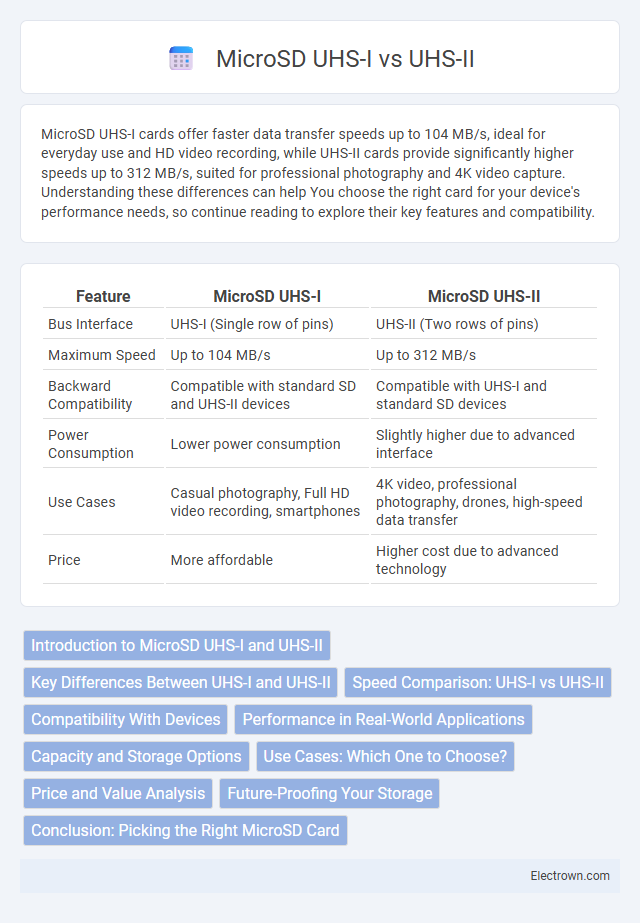MicroSD UHS-I cards offer faster data transfer speeds up to 104 MB/s, ideal for everyday use and HD video recording, while UHS-II cards provide significantly higher speeds up to 312 MB/s, suited for professional photography and 4K video capture. Understanding these differences can help You choose the right card for your device's performance needs, so continue reading to explore their key features and compatibility.
Table of Comparison
| Feature | MicroSD UHS-I | MicroSD UHS-II |
|---|---|---|
| Bus Interface | UHS-I (Single row of pins) | UHS-II (Two rows of pins) |
| Maximum Speed | Up to 104 MB/s | Up to 312 MB/s |
| Backward Compatibility | Compatible with standard SD and UHS-II devices | Compatible with UHS-I and standard SD devices |
| Power Consumption | Lower power consumption | Slightly higher due to advanced interface |
| Use Cases | Casual photography, Full HD video recording, smartphones | 4K video, professional photography, drones, high-speed data transfer |
| Price | More affordable | Higher cost due to advanced technology |
Introduction to MicroSD UHS-I and UHS-II
MicroSD UHS-I cards utilize the Ultra High Speed Bus Interface with a maximum theoretical transfer speed of up to 104 MB/s, suitable for Full HD video recording and standard photography. In contrast, MicroSD UHS-II cards feature an additional row of pins enabling double the bus speed, reaching up to 312 MB/s, which supports 4K video recording and rapid data transfer for professional-grade devices. Both standards are backward compatible, but UHS-II delivers enhanced performance for demanding applications like high-resolution imaging and fast file transfers.
Key Differences Between UHS-I and UHS-II
UHS-I microSD cards offer maximum theoretical speeds up to 104 MB/s, while UHS-II cards support speeds up to 312 MB/s due to an additional row of pins enabling faster data transfer. UHS-II technology provides improved bus interface and power efficiency, essential for high-resolution video recording and rapid file transfers. Compatibility varies as UHS-II cards function in UHS-I slots but at lower speeds, making UHS-II ideal for professional photography and 4K video applications.
Speed Comparison: UHS-I vs UHS-II
UHS-I microSD cards offer maximum transfer speeds up to 104 MB/s, while UHS-II cards significantly improve performance with speeds reaching up to 312 MB/s due to the extra row of pins enabling faster data transfer. This speed difference is critical for high-resolution video recording, 4K UHD photography, and rapid file transfers where UHS-II cards reduce latency and buffering. Compatibility with UHS-II devices ensures optimal utilization of these speeds, whereas UHS-I remains suitable for everyday tasks with moderate speed requirements.
Compatibility With Devices
MicroSD UHS-I cards offer broad compatibility with most devices, including smartphones, cameras, and tablets, as they support the standard SD card interface. UHS-II cards feature an additional row of pins for faster data transfer speeds but require devices specifically designed to read these pins to achieve optimal performance. Devices lacking UHS-II support can still use UHS-II cards but will operate at lower UHS-I speeds, limiting the benefits of the newer technology.
Performance in Real-World Applications
UHS-II microSD cards deliver significantly faster read and write speeds than UHS-I cards, enhancing performance in real-world applications like 4K video recording and rapid burst photography. You will notice reduced buffering and quicker file transfers, making UHS-II ideal for professional use and demanding workflows. Despite higher costs, the improved performance of UHS-II cards benefits devices that support the advanced bus interface, ensuring smoother usage and efficiency.
Capacity and Storage Options
MicroSD UHS-I cards typically offer storage capacities ranging from 16GB up to 1TB, making them suitable for everyday use in smartphones, cameras, and tablets. UHS-II cards provide similar capacity options but excel in faster read/write speeds due to their advanced bus interface, benefiting professional photographers and videographers requiring high throughput. Both formats support extensive storage needs, but choosing between them depends on the required speed performance rather than capacity limitations.
Use Cases: Which One to Choose?
MicroSD UHS-I cards suit everyday use such as smartphone storage, casual photography, and 1080p video recording due to their adequate speed and affordability. UHS-II cards are ideal for professional applications like 4K/8K video production, high-speed burst photography, and rapid file transfers, benefiting users who require maximum performance and reliability. Choosing between UHS-I and UHS-II depends on device compatibility, budget, and the need for faster read/write speeds in demanding environments.
Price and Value Analysis
MicroSD UHS-I cards generally offer a more affordable price point compared to UHS-II, making them a cost-effective choice for everyday use and standard devices. While UHS-II cards provide significantly faster read and write speeds, the premium price may not justify the incremental performance boost for casual users or typical smartphones. Your decision should balance budget constraints with the need for high-speed data transfer, especially if you require quick file handling for professional photography or 4K video recording.
Future-Proofing Your Storage
UHS-II MicroSD cards offer significantly faster read and write speeds than UHS-I, supporting up to 312 MB/s compared to UHS-I's 104 MB/s, making them ideal for future-proofing your storage needs. Devices increasingly demand higher performance for 4K video recording, gaming, and rapid data transfer, so choosing UHS-II ensures compatibility with upcoming technologies. Investing in UHS-II MicroSD cards helps you avoid frequent upgrades, maximizing storage longevity and efficiency.
Conclusion: Picking the Right MicroSD Card
Choosing between MicroSD UHS-I and UHS-II cards depends on your device compatibility and performance needs, with UHS-II offering faster read/write speeds up to 312 MB/s compared to UHS-I's maximum of 104 MB/s. UHS-II cards are ideal for professional photography, 4K video recording, and high-speed data transfer, while UHS-I remains suitable for everyday use and less demanding applications. Consider device support, budget, and intended use to ensure optimal storage performance.
MicroSD UHS-I vs UHS-II Infographic

 electrown.com
electrown.com